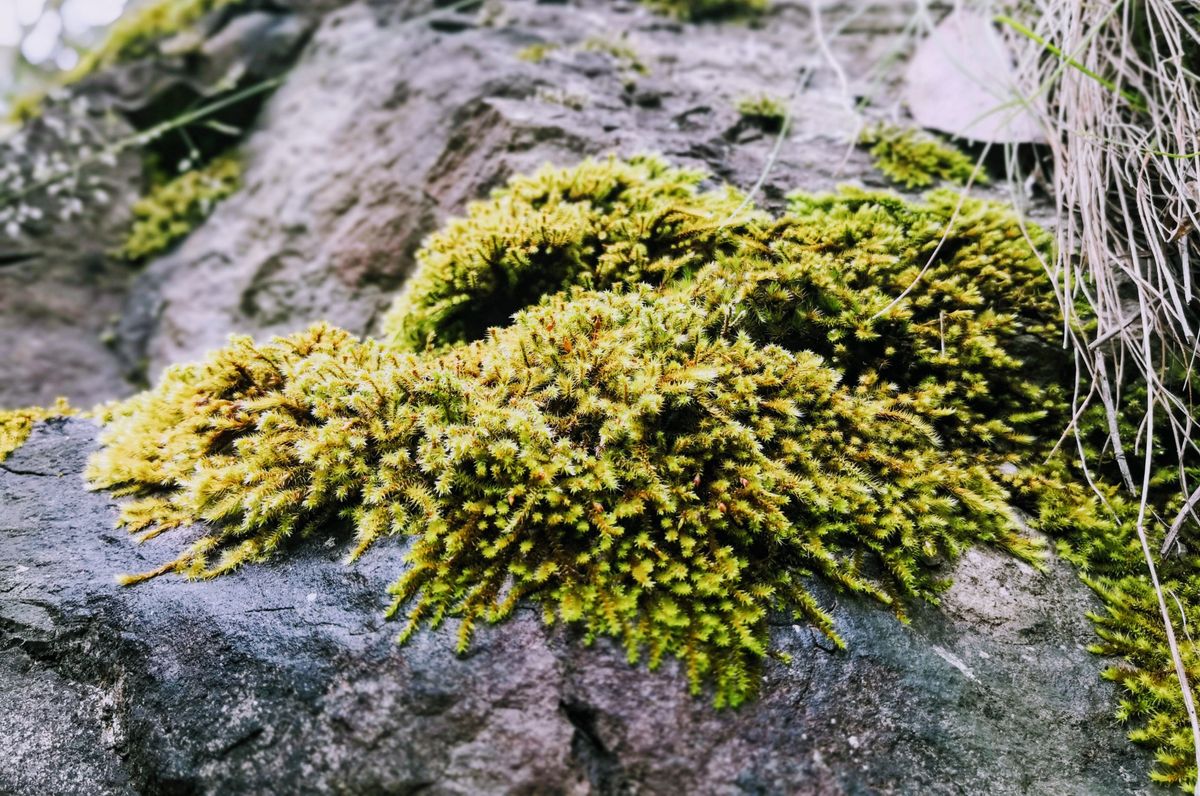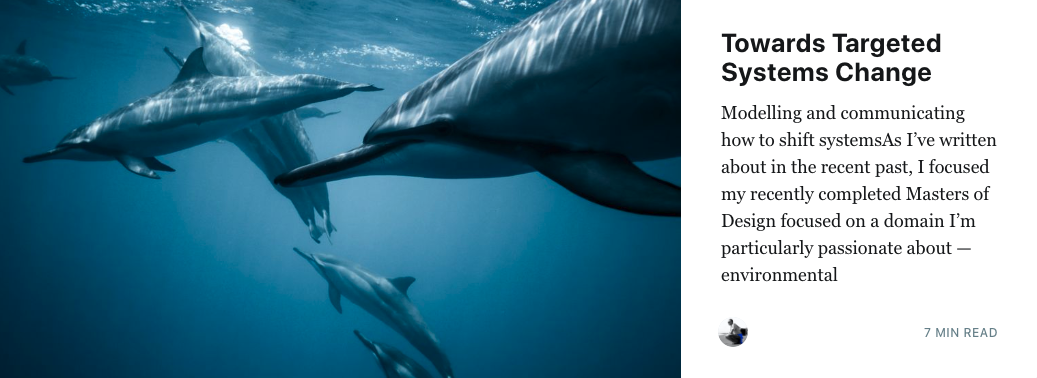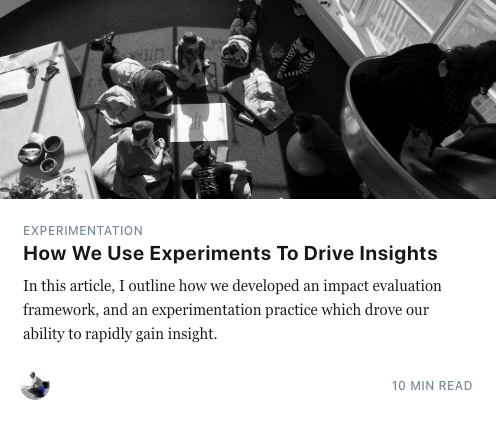End of 2018 Reflections: Perspectives on Systems Change, Strategic Design, and Seasonality
This post focuses on some professional and personal reflections from 2018, spanning my Masters, Consulting, and more. In it, I touch on systems change, experimentation, strategy, seasonality and nature.

This post is dedicated to my father, Mark, who passed away in February this year. Dad taught me so many important lessons about life, work, and what it means to try to bring a little joy to people’s lives.
This year has been difficult. The sudden passing of my father led to rapid shifting of priorities, the darkness of grief, and quiet support from a small cadre of very good humans. Thank you to you all, you brought light in a very dark year.
However this post isn’t about grief, it’s focused on some professional reflections from my work which has spanned Strategic/UX/UI Design for a fast growing food company, experimentation capacity building inside a prominent Australian University, interviews with systems practice pioneers, and of course — my Masters of Design, focused on systemic & strategic design for environmental conservation.
So, onwards… these are musings, half formed thoughts, not profound arguments. I write them as much as provocations for myself in 2019, as anyone else’s interest.
Professional Practice Learnings from 2018
On Systems Change
As I began to write up my Masters, I found that my perspectives on systems change work weren’t necessarily mainstream. By this, I mean that the dominant discourse on systems change, appears to be about societal transformation in some form.
Even articles which try to create separation between “the system” and “a system” seem to overlook that systems operate at many levels — from our own bodies, to families, peri-urban ecologies, digital platforms, societies, and beyond.
We need a deeper conversation, as systems change work cannot all be about societal-level transformation. We need to understand the nuances of practice at different scales, about how to identify the scope of intervention, and how we build better feedback loops and evaluation.
“systems change literature contains some important insights. Most fundamentally, that social problems are the product of networks of cause and effect — a fact that needs to be reflected in the way we act to improve them.” - NPC & Lankelly Chase - 'Systems change: A guide to what it is and how to do it.’ (2015).
To this end, my Masters focused on targeted systems change [1], which is a collection of initiatives which work collectively and sometimes symbiotically to influence the change in a system. In my mind, this works more with the new understandings of systems, emerging from complexity science.

On Experimentation
During my work with Monash University, I was working with the Design School’s research labs. Inherently, they are focused on designing new interventions, products, services and the likes, through research methods.
This was fertile ground for building capacity in a more experimental form of research — something I started calling atomic research, because we aimed to maintain the granular insights of research activities. The work was based on my original practice developed with Lifehack HQ, that I outlined in this article:

Whilst this experimentation mindset and culture seems fairly easily transplanted to researchers, the approach noticeably needs to break through to product, service, policy, day-to-day — the boring revolution — if it’s going to make a dent in the planning-centric methods we tend to use to tackle complex challenges.
Nesta’s piece, in which my article was featured, has a good outline of a spectrum of experimentation:
“Experimental approaches accelerate learning by systematically testing assumptions and identifying knowledge gaps. What is there to be known about the problem and the function, fit and probability of a suggested solution? Experimentation helps fill these gaps without allocating too much time or resource, and helps governments accelerate the exploration of new potential solution spaces.” - Quaggiotto, G., Leurs, B., Christiansen, J. - ‘Towards an experimental culture in government: reflections on and from practice’. (2017).
On Strategy
Design has been taking a big step into Strategic work lately (Anna Meroni’s paper from 2008 on Strategic Design is worth a read), yet ‘Strategy’ seems to be a term which is all too often bandied around without really being understood. Do people engaging in strategic work, understand the craft of Strategy, enough?
Likewise the implications of latest complexity science (Jean Boulton’s 2015 book is a good entry point) for strategy formation are little-understood, and different approaches to strategic work (adaptive, emergent etc) are still not well understood.
“A strategy is not a fixed plan, nor does it change systematically at pre-arranged times solely at the will of management. The dichotomy between strategy formulation and strategy implementation is a false one under certain common conditions, because it ignores the learning that must often follow the conception of an intended strategy.” - Henry Mintzberg - ‘Patterns in Strategy Formation’. (1978)
Generally, we need to get better at understanding the unseen ‘dark matter’ of challenges (Hill, 2014 [2]) in order to be more effective in strategic work which inherently is more about the wider system at play. Thus, in my opinion, as Designers we need to be part of an organisation, or very close collaborators to do this work well — yet the majority of strategic design seems to be operating from an agency/consulting model at this stage.
How do we best enabling Strategic Design capacity in organisations, or in networks of collaborators working on complex challenges?
Personal Practice Learnings from 2018
On Seasons
In talking with the excellent Lina Patel & Seanna Davidson recently, I talked a little about the seasonality which is implicit in the way I work. Traditionally, I’ve talked about working to Spring/Summer/Autumn/Winter rhythms, but as I sat on my deck looking out over the Yarra Ranges of the Kulin Nation, I recognised that I no longer live in northern hemisphere seasons, I live in Wurundjeri ones.

I see this as a great opportunity! More seasons to pay attention to, and allow myself to steep in their uniqueness. How can we unlock collaborative endeavours in the cool, foggy mornings of Warin Wombat season? What kind of creativity is spurred by Biderap Dry Season?
On Nature's Wisdom
As I wrote about my practice for my Masters of Design, I realised how deeply I draw on natural phenomena for inspiration, sensemaking and synthesis. I included a little about it in the activities associated with the Story of Strategy.
I remember hearing Janine Benyus of Biomimicry Institute talking about learning from 3.8 billion years of R&D, and I feel the same about my connection to the natural world. There’s so much wisdom — strategies that have enabled species to survive and thrive across the millennia — we just need to engage our senses and our sense of wonder.
As evolutionary biologist, Elisabet Sahtouris, once said:
“No business has ever faced a problem, that a rainforest hasn’t already solved.”
Looking forward to 2019
So, a very brief glimpse forward, here’s some very light touch intentions, until I’ve had a decent chance to inflect with Year Compass.
- I’m delighted to say that rachel sinha & Tatiana Fraser look to be running one of their Systems Sanctuary programs for a New Zealand & Australian audience. I’m keen to help build an interesting and diverse cohort, especially filled with anyone interested in working around Biodiversity Loss & Climate Change.
- As I reflected on where the world is going, and where I want to put my energy, I realised that I need to return to my environmental focus. There’s many different paths for this — from bringing my Masters concepts to fruition, working closely with or within an organisation in this space, or even starting to convene the biodiversity lab I’ve been talking about.
- One fundamental building block of this kind of systemic work is the need for collaborative pursuit of challenges, and the need to build capacity, culture and practice in the likes of Systemic Design, Complexity, Experimentation and Strategy. I’ve been dabbling with this on a small scale, but 2019 might hold some more serious work in this space.
- One thread that came up in discussions at the end of 2017, was about new financial and organisational models for agency/consulting outfits to address funding gaps for experimental initiatives and impact projects — “pre-client work” per se. This may be something I focus on, if I don’t find the right organisation to work with / in.
- Wild Work — a concept my new good pal, Alice Howard-Vyse, introduced me to. It feels like a natural extension of my personal practice reflections above, to find spaces and opportunities to deepen my connection and investment in this country on which I live.
For now, that’s my half thoughts and ponderings. I hope to write more about projects, experiments and my wayfinding exploits we whip around the sun once more.
If you want to get in touch, say hello here, or on twitter.
References
[1] Mühlenbein, O. (2018). Systems Change — Big or Small? Stanford Social Innovation Review, February, 3–6. Retrieved from https://ssir.org/articles/entry/systems_changebig_or_small
[2] Hill, D. (2014). Dark Matter and Trojan Horses: A Strategic Design Vocabulary. Strelka Press. Retrieved from https://strelka.com/en/press/books/dark-matter-and-trojan-horses-a-strategic-design-vocabulary





